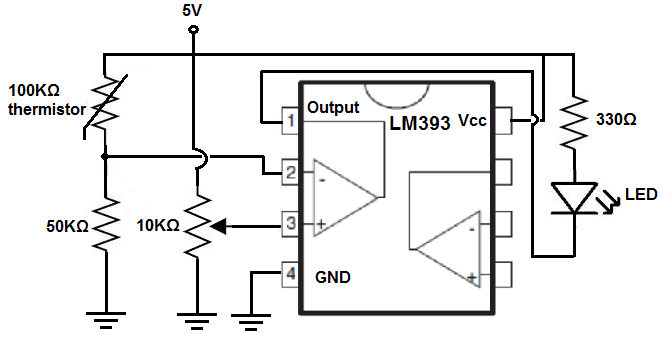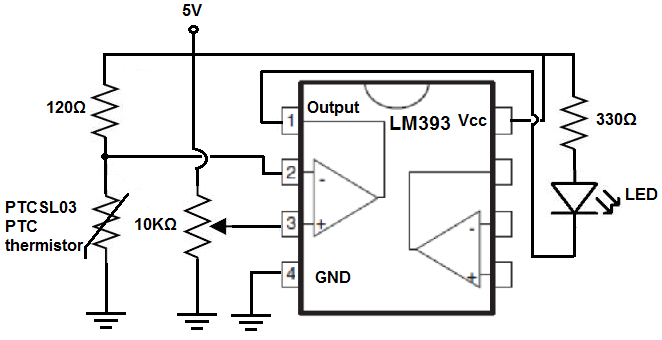How to Build Simple Thermistor Circuits

In this article, we go over how to build simple thermistor circuits.
A thermistor is a specialized resistor which changes resistance value depending on the amount of heat which it is exposed to. Its main characteristic is that it is thermally sensitive; in response to the heat it is exposed to, it alters its electrical resistances to changes in temperature. It can be used to measure temperature, or to sense temperature changes and act accordingly for the temperature changes, depending on its designed use for the circuit.
There are 2 main types of thermistors; negative temperature coefficient (NTC) thermistors and positive temperature coefficient (PTC) thermistors. NTC thermistors are thermistors whose resistance decreases when the temperature they are exposed to increases. PTC thermistors are thermistors whose resistance increases when the temperature they are exposed to increases.
In this article, we do examples with both NTC and PTC thermistors.
Thermistor Circuits
NTC Thermistor Circuit
PTC Thermistor Circuit
NTC Thermistor Circuit
Components Needed
- 100KΩ NTC Thermistor
- LM393 Voltage Comparator
- 50KΩ Resistor
- 330Ω Resistor
- LED
- Potentiometer
NTC thermistors can are widely available by online retailers in a number of different resistance values. You can see an assortment of thermistors at the following link- Tayda Electronics- Thermistors. However, as mentioned, in this circuit, we will use the 100KΩ thermistor. This is a thermistor that at room temperature has about 100KΩ of resistance and when exposed to very hot temperatures has a resistance in the range of 30KΩ. Thus, there is a significant drop in resistance. We will exploit this principle with a voltage comparator to build a circuit that can sense and react to these temperature changes.
The voltage comparator we will use is the LM393. This can be obtained from the same retailer at the following link- Tayda Electronics- LM393 Voltage Comparator. To find out how to use this chip extensively and to see a complete pinout and explanation of its pin, see the article, How to Build an LM393 Voltage Comparator Circuit. This comparator will is the heart of the circuit besides the heat-sensing thermistor because with it, we can detect temperatures and respond to when there are changes.
How the circuit actually operates, step by step, will be explained in full detail below.
NTC Thermistor Circuit
The NTC thermistor circuit we will build is shown below.

Before we begin, adjust the potentiometer so that the LED is off when there is no heat applied to the thermistor and on when heat is applied to the thermistor. The potentiometer, which can be of any value, functions as a calibrator. It sets a reference voltage level that will serve as the threshold level for what triggers the LED on and off, meaning when the voltage across the thermistor is greater than the reference voltage, the LED will be off. When the voltage across the thermistor is less than the reference voltage, the LED wil turn on. Thus, this is an important adjustment.
How this circuit works is we form a voltage divider circuit between the 100KΩ thermistor and a 50KΩ fixed resistor. At room temperature, the thermistor offers its nominal value of near 100KΩ. Voltage divides in a voltage divider circuit according to the resistance of each of the components, based on Ohm's law, V= IR. Thus, the greater the resistance of a component, the more voltage that drops across it. The lower the resistance, the less voltage that falls across it. Since at room temperature, the thermistor offers 100KΩ of resistance and the fixed resistor offers 50KΩ, most of the voltage will drop across the thermistor and very little across the fixed resistor. Thus, the voltage across the fixed resistor is very low, lower than the reference voltage set by the potentiometer. With the voltage lower at the inverting terminal than at the noninverting terminal, the output will be drawn high to VCC and the LED will be off.
However, with very hot heat applied to the thermistor, its resistance drops significantly in the range of about 30KΩ. It now has a resistance below that of the fixed resistor. So most of the voltage will fall across the fixed resistor and not the thermistor. Now the voltage across the inverting terminal will be greater than at the noninverting terminal. With the voltage at the inverting terminal being greater than at the noninverting terminal, the output will be drawn to ground and the LED will turn on.
So the LED is off when the thermistor is exposed to room temperature and on when the thermistor is exposed to very hot temperature.
And this is how a simple NTC thermistor circuit can be built.
PTC Thermistor Circuit
Now we will build a simple PTC thermistor circuit.
Components Needed
- PTCSL03 PTC Thermistor
- LM393 Voltage Comparator
- 120Ω Resistor
- 330Ω Resistor
- LED
- Potentiometer
The thermistor we will use in this circuit is the PTCSL03.
At room termperature, about 70 degrees Fahrenheit (21 degrees celsius), the thermistor has a resistance of about 50Ω. As the thermistor is exposed to high heats, the resistance rises rapidly from this resistance and can reach several kilohms of resistance.
The PTC thermistor, unlike the NTC, increases in resistance with increasing temperature.
The datasheet for the SL03 PTC thermistor can be found at the following link: PTCSL03 PTC Thermistor Datasheet.
A thermistor acts as a variable resistor which changes in accordance to the amount of heat that the
thermistor is exposed to. We exploit this principle in this circuit to form a voltage divider. The voltage
comparator then reads this voltage and is able to turn on an LED, which indicates a heat overload status, so to speak.
The circuit we will build is shown below:

So we supply about 5V of power to the LM393 voltage comparator chip. This supplies sufficient power for the chip to operate and sufficient power to turn on the LED. If we were powering on a device that needed higher power such as a 12V DC motor, for instance, we would need at least 12V of power. However, for an LED, 5V is sufficient.
How this circuit works is based on the principle of a voltage divider. The voltage supplied to the circuit is 5VDC. This 5V gets divided up between the 120Ω and the thermistor.
This voltage divider circuit is fed into the inverting terminal of the voltage comparator.
The potentiometer functions to set the voltage reference level fed into the noninverting terminal. The potentiometer allows us to calibrate the level of the level of heat that trigger on the LED, indicating heat overload.
How a voltage comparator chip works is that when the voltage at the inverting terminal is greater than at the noninverting terminal, the load at the output, in this case an LED turns on.
So the voltage at the noninverting sets the reference level.
If the voltage at the inverting terminal exceeds this level, the output turns on.
So we set the reference voltage level via the calibrating potentiometer. If you are using a 10KΩ resistor and you set the resistance to the halfway point of 5KΩ, the voltage at the noninverting terminal will be half of the supply voltage, which is 2.5V. Therefore, if the voltage at the inverting terminal exceeds 2.5V, the output will turn on. This will happen when the thermistor's resistance exceeds 120Ω.
So this is how the circuit works in a nutshell.
If we calibrate the potentiometer so that the reference voltage is greater, then the thermistor needs be exposed to a higher heat to have a higher resistance. Therefore, a higher reference voltage increases the heat threshold for which the LED turns on. This means the thermistor must be exposed to a higher heat for the overload heating LED to turn on.
In the same way, calibrating the potentiometer so that the reference voltage is lower, then the thermistor needs to be exposed to a lower heat to turn on. Therefore, a lower reference voltage decreases the heat threshold for which the LED turns on. This means the thermistor is more sensitive to heat and will trigger the overload heating LED to turn on at lower heat exposure.
And this is how a PTC thermistor circuit can be built.
These simple circuits help to show how NTC and PTC thermistors work. While NTC thermistor's resistance value decreases while the temperature it is exposed to increases, PTC thermistor's
resistance value increases when the temperature it is exposed to decreases. Thus, in circuits, circuit designers can exploit these principles to accomplish the needed task in a circuit
to compensate for temperature fluctuations which may exist.
Related Resources
How to Test a Thermistor
Thermistor Resistance- Explained
